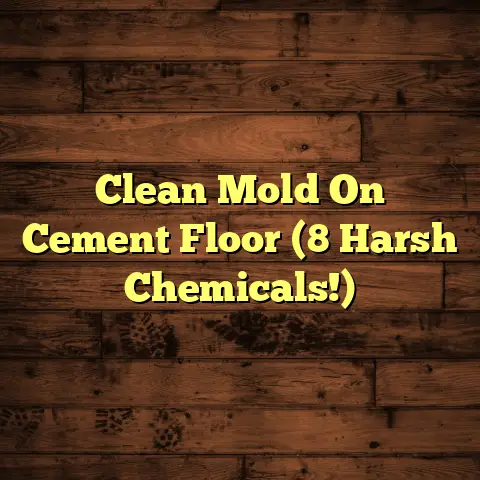Best Flooring Solutions For Basement Bathrooms? (Explained)
Choosing the right flooring for a basement bathroom can be tricky due to moisture and humidity concerns.
After years of working as a flooring contractor, I’ve learned that one solution stands out for its durability and water resistance: luxury vinyl plank (LVP) flooring.
This versatile material offers the look of hardwood or tile while being exceptionally resilient in wet environments.
Understanding Your Basement Bathroom Environment
Basements often have a unique set of challenges.
The combination of high humidity and potential flooding makes it crucial to select flooring that can withstand these conditions.
When I first started working on basement projects, I encountered issues such as warped wood and moldy carpets.
Those experiences taught me the importance of choosing the right materials from the start.
The Unique Challenges of Basement Bathrooms
Basement bathrooms can be particularly tricky. Here are some challenges I’ve faced:
- Moisture Control: Basements are usually more humid than above-ground spaces.
This means that any flooring material used must be able to resist moisture effectively. - Temperature Fluctuations: Depending on the season, basements can be cooler in winter and warmer in summer.
Flooring materials need to adapt without warping or cracking. - Potential Water Damage: Flooding or leaks can occur, particularly if plumbing issues arise or heavy rains lead to water seepage.
It’s essential to consider how well the flooring material can handle these situations.
I remember one project where a family wanted their basement bathroom to resemble a rustic cabin.
They chose a wood-look LVP that perfectly complemented their vision while providing the necessary water resistance.
Why I Prefer Luxury Vinyl Plank
Luxury vinyl plank has become my go-to choice for basement bathrooms for several reasons:
- Water Resistance: LVP is entirely waterproof, making it perfect for areas prone to moisture.
- Ease of Installation: I appreciate that LVP can be installed as a floating floor or glued down, depending on the situation.
- Aesthetic Options: With various styles available, homeowners can achieve the desired look without sacrificing functionality.
Real-Life Example: A Successful LVP Installation
In one particular job, I had a client who wanted a spa-like atmosphere for their basement bathroom.
We selected a light oak LVP that mimicked the look of natural wood.
The installation process was straightforward, and the results were stunning.
The family was thrilled with how the flooring transformed their space.
However, not every project goes off without a hitch.
I once had an issue with a batch of LVP that had a manufacturing defect, leading to visible seams after installation.
Thankfully, the supplier was quick to replace the planks, but it taught me the importance of quality checks before installation.
Cost Considerations
When estimating costs for flooring projects, I often rely on FloorTally.
This tool helps me gather local material and labor rates, enabling me to provide accurate quotes to my clients.
For a typical basement bathroom, luxury vinyl plank can range from $2 to $7 per square foot, depending on the quality and style chosen.
Here’s how I would break down costs for a 100-square-foot bathroom:
- Material Costs: $200 – $700
- Installation Costs: $150 – $300
- Additional Costs: Underlayment, trim, and any necessary repairs might add another $100 – $200.
This means the total could range from $450 to $1,200.
FloorTally’s accurate estimates save me time, allowing me to focus on installations instead of endless calculations.
Budgeting Tips for Basement Bathroom Renovations
When working with clients on budgeting for a basement bathroom renovation, I always emphasize the importance of planning for unexpected expenses.
Here are some budgeting tips based on my experience:
- Account for Hidden Costs: Always consider costs like plumbing modifications, electrical work, and any structural changes needed.
- Choose Quality Over Quantity: Investing in higher-quality materials can save money in the long run by reducing maintenance and replacement needs.
- Plan for Accessories: Don’t forget about fixtures like sinks, toilets, and lighting when budgeting for your bathroom renovation.
- Get Multiple Quotes: If you’re hiring professionals, always get several quotes to ensure you’re getting a fair price.
- Allocate a Contingency Fund: Set aside an additional 10-15% of your total budget for unexpected expenses that may arise during the renovation process.
Comparing Flooring Options
Tile Flooring
Tile is a popular option due to its durability and water resistance.
However, it can be cold underfoot, which is something to consider if the bathroom doesn’t have heated floors.
I once installed ceramic tiles in a basement bathroom.
While the look was fantastic, it took longer than expected due to the need for precise cuts around plumbing fixtures.
Plus, if grout isn’t sealed properly, it can lead to mold growth over time.
Pros and Cons of Tile Flooring
- Pros:
- Highly durable and long-lasting
- Water-resistant
- Wide variety of styles and colors
- Cons:
- Cold underfoot without heating
- Difficult installation process
- Grout maintenance can be challenging
Laminate Flooring
Laminate can mimic wood but isn’t always suitable for damp areas.
I’ve had clients who loved the look of laminate only to face issues when water leaks occurred.
Even with water-resistant options, laminate tends to swell when exposed to moisture.
Pros and Cons of Laminate Flooring
- Pros:
- Affordable option
- Wide variety of styles
- Easy to install
- Cons:
- Not fully waterproof
- Can warp if exposed to moisture
- Limited lifespan compared to other materials
Concrete Flooring
Some clients opt for polished concrete for its industrial aesthetic.
While it’s incredibly durable, it lacks warmth and comfort underfoot.
I had one client who loved the minimalist vibe but quickly regretted their choice during the winter months when the floor felt icy.
Pros and Cons of Concrete Flooring
- Pros:
- Extremely durable
- Low maintenance
- Unique design possibilities
- Cons:
- Cold and hard underfoot
- Can crack over time
- Installation can be labor-intensive
Installation Tips and Tricks
When installing luxury vinyl plank in a basement bathroom, there are several tips I’ve gathered over the years:
- Prepare the Subfloor: Make sure it’s clean and dry before installation.
Any debris or moisture can lead to problems down the line. - Allow Acclimation: Let LVP acclimate in the bathroom for 48 hours before installation.
This prevents expansion or contraction after installation. - Use Quality Underlayment: A good underlayment can provide sound insulation and additional moisture protection.
- Plan for Expansion Gaps: Remember to leave expansion gaps along walls and fixtures to allow the material to shift without buckling.
- Consider Lighting: The color of the flooring can change based on lighting; always check samples in different light conditions.
- Utilize Proper Tools: Having the right tools makes installation easier—invest in a good utility knife, measuring tape, and straight edge.
- Follow Manufacturer Instructions: Every flooring product has specific guidelines; following these ensures the best results.
A Personal Anecdote on Installation
I once had a project where I worked alongside a DIY enthusiast who wanted to install LVP herself.
She was excited but nervous about making mistakes.
I guided her through each step—from measuring to cutting—and we ended up with beautiful results.
It was rewarding to see her excitement when she realized she could tackle such a big project with confidence.
Maintenance Made Easy
Another reason I love luxury vinyl plank is its low maintenance requirements.
To keep it looking fresh, regular sweeping and occasional mopping with a gentle cleaner is all it takes.
During one job, my client was amazed at how easy it was to clean compared to their previous carpeted bathroom.
Long-Term Care Tips
To ensure your LVP remains in top shape over time, here are some long-term care tips:
- Regular Cleaning: Sweep or vacuum regularly to remove dirt and debris that can scratch the surface.
- Avoid Harsh Chemicals: Use mild cleaning solutions specifically designed for vinyl flooring; harsh chemicals can damage the finish.
- Protect from Scratches: Place felt pads under furniture legs and avoid dragging heavy items across the floor.
- Monitor Humidity Levels: Keep humidity levels consistent in your basement using dehumidifiers if necessary.
- Inspect Regularly: Periodically check for any signs of damage or wear so you can address issues before they become significant problems.
Final Thoughts
Choosing the best flooring for basement bathrooms boils down to understanding your unique needs and environment.
While luxury vinyl plank has proven to be an excellent option for many of my clients due to its durability and aesthetic versatility, other materials like tile and concrete also have their place depending on individual preferences.
If you’re considering a renovation or new installation, think about your lifestyle and how you’ll use the space.
Ask yourself questions like:
- Will there be frequent water exposure?
- How important is warmth underfoot?
- What kind of maintenance are you willing to commit to?
By weighing these factors carefully and utilizing tools like FloorTally for accurate cost estimations, you’ll be well-equipped to make an informed decision on your basement bathroom flooring.
With each project I undertake, I’ve come to realize that flooring isn’t just about aesthetics or functionality—it’s about creating spaces that feel like home.
Whether it’s a cozy retreat or a sleek modern bathroom, your choice of flooring plays a pivotal role in achieving that vision.
A Comparative Analysis of Flooring Solutions
To help you make your decision easier, let’s compare these flooring options side by side based on key factors:
This table summarizes how each option stacks up against others in terms of various factors important for basement bathrooms.
Additional Considerations
When selecting flooring for basement bathrooms, consider additional factors that might influence your decision:
- Style Preferences: What aesthetic do you want?
Modern?
Rustic?
Traditional?
Luxury vinyl plank offers numerous design choices to suit any taste. - Installation Timeframe: Are you looking for something quick?
Laminate may be faster than tile or concrete. - Environmental Impact: If sustainability is essential for you, research eco-friendly options available in luxury vinyl or consider reclaimed wood for other types of flooring.
- Local Climate Conditions: Depending on where you live, moisture issues may vary; choose materials suited for your specific environment.
- Future Renovations: If you plan on renovating again soon, consider how easily each type of flooring can be removed or replaced.
My Journey as a Flooring Contractor
Over my years as a flooring contractor, I’ve experienced quite an evolution in terms of materials and techniques available in the market today.
Early in my career, I primarily dealt with hardwood and carpet—both of which presented their own set of challenges in terms of maintenance and moisture control.
As trends shifted towards more versatile options like LVP and engineered hardwoods, I adapted my skill set accordingly.
Each project brought new learning experiences—some incredible successes and others that taught me valuable lessons about preparation and customer communication.
One memorable job involved a large family home with an extensive basement remodel that included not just bathrooms but also living spaces.
We opted for LVP throughout due to its resilience against spills from kids playing and pets running around.
The family was thrilled with how seamless everything looked—and when they hosted gatherings afterward, they received countless compliments!
It reinforced my belief in selecting quality materials that align with both aesthetic desires and practical needs.
Conclusion: Making Your Choice
Ultimately, selecting flooring for your basement bathroom should involve careful consideration of your specific needs and preferences.
Luxury vinyl plank stands out as one of my top recommendations due to its water resistance, ease of maintenance, and aesthetic flexibility.
However, other options like tile or polished concrete also have their merits depending on individual circumstances—just weigh all factors carefully before making your decision!
Armed with this knowledge—as well as insights drawn from years spent working closely with clients—you’re now better equipped than ever before!
Whether you choose LVP or explore alternatives like tile or laminate floors—remember there’s no one-size-fits-all solution!
So take your time exploring different styles while keeping practicalities at heart! Happy renovating!





